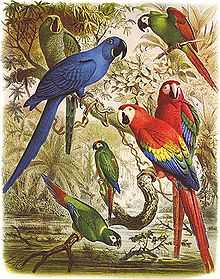Glaucous Macaw
| Glaucous Macaw | |
|---|---|
 | |
| Illustration by Bourjot Saint-Hilaire | |
| Conservation status | |
| Scientific classification | |
| Kingdom: | Animalia |
| Phylum: | Chordata |
| Class: | Aves |
| Order: | Psittaciformes |
| Family: | Psittacidae |
| Genus: | Anodorhynchus |
| Species: | A. glaucus |
| Binomial name | |
| Anodorhynchus glaucus (Vieillot, 1816) | |
The Glaucous Macaw (Anodorhynchus glaucus) is a large all blue South American parrot, a member of a large group of Neotropical parrots known as macaws. This macaw, generally believed to be extinct, was closely related to the Lear's Macaw A. leari and the Hyacinth Macaw A. hyacinthinus. In Guaraní, it was called guaa-obi after its vocalizations.
Description


The Glaucous Macaw is 70 centimetres (28 in) long. It is mostly pale turquoise-blue with a large greyish head. The term glaucous describes its colouration. It has a long tail and a large bill. It has a yellow, bare eye-ring and half-moon-shaped lappets bordering the mandible.[2]

Range and decline
This bird was native to north Argentina, south Paraguay, north-east Uruguay and Brazil. It became rare during the 19th century due to trapping and loss of habitat, and only two possible reports of wild birds were received in the 20th century. Expeditions by ornithologists to southwestern Paraguay during the 1990s failed to turn up any evidence that the bird was still in existence. Furthermore, only the oldest residents of the region had knowledge of the macaw, with the species last recorded in the 1870s.[1] It is most probable that the bird's disappearance is linked to trapping of live adults for the wild bird trade and the wholesale felling of the Yatay Palm, Butia yatay, whose nuts appear to have constituted its main food. However, suitable habitat remains in El Palmar National Park in the Argentine province of Entre Ríos as well as southern Brazil, however, no rumours of the bird's continued existence in the past several decades have been proven credible.
References
- ↑ 1.0 1.1 BirdLife International (2013). "Anodorhynchus glaucus". IUCN Red List of Threatened Species. Version 2013.2. International Union for Conservation of Nature. Retrieved 26 November 2013.
- ↑ "Species factsheet: Anodorhynchus glaucus". BirdLife International (2008). Retrieved 24 July 2008.
External links
- 3D view of specimens RMNH 110.103 and RMNH 110.114 at Naturalis, Leiden (requires QuickTime browser plugin).
- The Glaucous Macaw at Bluemacaws.org
| |||||||||||||||||||||||||||||
